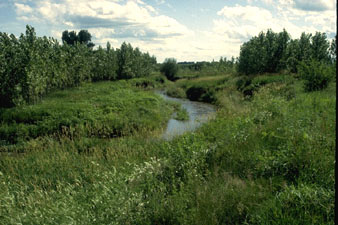What is it?
Riparian forest buffers are strips of trees, shrubs and grass planted between cropland or pasture and surface water courses. Buffers protect water quality, reduce erosion and flooding. Riparian forest buffers can provide beneficial opportunities for row crop farmers, ranchers, horticulturists, and dairy and livestock producers.
Benefits: Riparian forest buffers provide economic, social and environmental benefits:
Water quality. Buffers have been shown to reduce non-point source pollution by absorbing and filtering animal wastes, sediments, nutrients and pesticides from crop and rangelands.
Erosion and flood control. Riparian buffers combined with bioengineering practices help stabilize streambanks, slow out-of-bank flood flows, and protect cropland from flooding.
Extra Income. Multirow riparian buffers can be managed to allow the periodic harvest of timber or non-timber products while still maintaining buffering capacity. This helps offset the loss of productive crop or pasture land to buffers.
Wildlife habitat. Riparian forest buffers provide shade, shelter and food for fish and aquatic organisms, as well as terrestrial wildlife.
Design & Management: Riparian forest buffers are designed to fulfill different purposes
How a riparian buffer functions, and the services it provides, depends on its length and width, the variety of plant species included, and how it is managed after establishment. The standard design for riparian buffers suggested by the USDA Natural Resource Conservation Service consists of three distinct zones (see diagram below). This standard is modified on a case by case basis to suit the goals of the individual landowner and the characteristics of the site. Whatever the design, careful monitoring and active management are required after establishment to keep buffers functioning as intended.

Cross section of a three-zone riparian forest buffer (adpated from USDA NRCS Riparian Forest Buffer Conservation Practice Job Sheet 391)
Grow specialty nontimber crops in riparian areas
A variety of potential agroforestry enterprises based on trees and shrubs planted in buffers have been suggested. These include special forest products such as botanical, medicinal, floral and edible products, Christmas trees, timber production, and wildlife recreation. In the three-zone model of a riparian forest buffer, the intermediate area (Zone 2) and the area next to the cropland (Zone 3) are more suitable than Zone 1 for active management and production of trees and shrubs for a variety of products. In the Pacific Northwest, for example, a variety of native plants could be cultivated for saleable products beneath the tree canopy in any zone of a riparian buffer, e.g., Cascara (Rhamnus purshiana), Oregon grape (Mahonia aquifolium), Red elderberry (Sambucas racemosa), Sword Fern (Polystichum munitum), and Salal (Gaultheria shallon). Christmas trees, such as Douglas fir (Pseudotsuga menziesii) could be grown in Zone 2 on a 7-8 year rotation.
Buffers protect water quality
Riparian buffers consisting of a combination of trees, shrubs and grasses are proven effective in trapping and filtering sediments, nutrients and chemicals in runoff from cropland and pastures. Plants absorb nutrients and chemicals that would otherwise flow into adjacent waterways. In order to be effective for water quality protection, buffers need to be sufficiently wide to slow down overland flow velocity and allow adequate time for nutrient uptake and sediment trapping. Since nutrients and sediments accumulate within plant tissue and on the surface of herbaceous species, maintenance of filtering capacity requires either long term storage (in large trees) or periodic harvesting to stimulate new growth which has a greater capacity to absorb nutrients.
Buffers reduce soil erosion
Plants in riparian buffers help control soil erosion by stabilizing soil with their roots and acting as a physical barrier to reduce overland water flows. By slowing down the water, they promote infiltration and reduce channel flow and gully formation. Deep-rooted trees and shrubs stabilize stream banks and reduce erosion and sedimentation. Grasses The spreading fibrous roots of grass species bind soil to reduce erosion and their fine foliage at ground level traps sediment.
Buffers improve habitat for fish and terrestrial wildlife
Riparian buffers create habitat for both aquatic and terrestrial wildlife. Large trees adjacent to streams moderate stream temperatures through shading, and provide a source of large woody debris. Salmon, for example, need cool water temperatures and streambed gravel free of excess sediment for reproduction. Large fallen logs in streams catch and scour the gravel vital to salmonid reproduction and provide them places to hide from predators. Native trees and shrubs also provide terrestrial birds and animals with food, cover, nesting sites and travel corridors.


